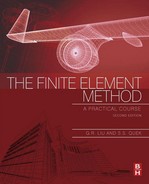Table of Contents
Chapter 1. Computational Modeling
1.2 Physical problems in engineering
1.3 Computational modeling using FEM
Chapter 2. Briefing on Mechanics for Solids and Structures
2.2 Equations for three-dimensional solids
2.3 Equations for two-dimensional solids
2.4 Equations for truss members
Chapter 3. Fundamentals for Finite Element Method
3.2 Strong and weak forms: problem formulation
3.3 Hamilton’s principle: A weak formulation
3.6 Analysis of free vibration (eigenvalue analysis)
4.4 High order one-dimensional elements
5.5 Case study: resonant frequencies of micro-resonant transducer
6.2 FEM equations for planar frames
6.3 FEM equations for space frames
6.5 Case study: finite element analysis of a bicycle frame
Chapter 7. FEM for Two-Dimensional Solids
7.2 Linear triangular elements
7.3 Linear rectangular elements
7.4 Linear quadrilateral elements
7.5 Elements for axisymmetric structures
7.6 Higher order elements—triangular element family
7.8 Elements with curved edges
7.9 Comments on Gauss integration
7.10 Case study: Side drive micro-motor
Chapter 8. FEM for Plates and Shells
8.5 Case study: Natural frequencies of the micro-motor
8.6 Case study: Transient analysis of a micro-motor
Chapter 9. FEM for 3D Solid Elements
9.5 Elements with curved surfaces
9.6 Case study: Stress and strain analysis of a quantum dot heterostructure
Chapter 10. Special Purpose Elements
10.3.3 Coupling of FEM and the boundary element method
Chapter 11. Modeling Techniques
11.10 Other applications of MPC equations
11.11 Implementation of MPC equations
Chapter 12. FEM for Heat Transfer Problems
12.2 Weighted residual approach for FEM
12.6 Case study: Temperature distribution of heated road surface
Chapter 13. Using FEM Software Packages
13.2 Basic building block: keywords and data lines
13.4 ABAQUS input syntax rules
13.5 Defining a finite element model in ABAQUS
